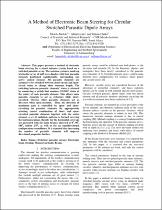 ResearchSpace
ResearchSpace
Method of electronic beam steering for circular switched parasitic dipole arrays
JavaScript is disabled for your browser. Some features of this site may not work without it.
- ResearchSpace
- →
- Research Publications/Outputs
- →
- Conference Publications
- →
- View Item
| dc.contributor.author |
Mofolo, M

|
|
| dc.contributor.author |
Lysko, Albert A

|
|
| dc.contributor.author |
Clarke, W

|
|
| dc.date.accessioned | 2010-09-29T09:32:11Z | |
| dc.date.available | 2010-09-29T09:32:11Z | |
| dc.date.issued | 2010-09 | |
| dc.identifier.citation | Mofolo, M, Lysko, A.A. and Clarke, W. 2010. Method of electronic beam steering for circular switched parasitic dipole arrays. Southern Africa Telecommunication Networks and Applications Conference (SATNAC), Spier Estate, Stellenbosch, South Africa, 5-8 September 2010, pp 6 | en |
| dc.identifier.uri | http://hdl.handle.net/10204/4399 | |
| dc.description | Southern Africa Telecommunication Networks and Applications Conference (SATNAC), Spier Estate, Stellenbosch, South Africa, 5-8 September 2010 | en |
| dc.description.abstract | This paper presents a method of electronic beam steering for a smart antenna system based on a switched parasitic array. The antenna system is made up of circular array of half wave dipoles, with four parasitic elements positioned equidistantly, surrounding one active central element. All parasitic elements are assumed to be switched between short-circuit and opencircuit states to change their resonant length. The switching between parasitic elements’ states is attained by connecting a switch that assumes ON/OFF states at the centre of each parasitic element. This allows some parasitic elements to act as reflectors while shortcircuited, whereas other parasitic elements act as directors when open-circuited. Thus, the direction of maximum gain is controlled by open- and shortcircuiting the parasitic elements. By appropriately selecting correct combination of short- and opencircuited parasitic elements together with the active element, a set of radiation patterns is formed covering the horizontal plane. Results for the horizontal coverage are presented with the main beam(s) directed at 00, 900, 1800, and/or 2700, as well as for an omnidirectional configuration resemblance. It is expected that increasing the number of parasitic elements will improve directional properties further. | en |
| dc.language.iso | en | en |
| dc.publisher | Southern Africa Telecommunication Networks and Applications Conference | en |
| dc.subject | Switched parasitic arrays | en |
| dc.subject | Electronic beam steering | en |
| dc.subject | Moment methods | en |
| dc.subject | Beams | en |
| dc.subject | Telecommunication networks | en |
| dc.title | Method of electronic beam steering for circular switched parasitic dipole arrays | en |
| dc.type | Conference Presentation | en |
| dc.identifier.apacitation | Mofolo, M., Lysko, A. A., & Clarke, W. (2010). Method of electronic beam steering for circular switched parasitic dipole arrays. Southern Africa Telecommunication Networks and Applications Conference. http://hdl.handle.net/10204/4399 | en_ZA |
| dc.identifier.chicagocitation | Mofolo, M, Albert A Lysko, and W Clarke. "Method of electronic beam steering for circular switched parasitic dipole arrays." (2010): http://hdl.handle.net/10204/4399 | en_ZA |
| dc.identifier.vancouvercitation | Mofolo M, Lysko AA, Clarke W, Method of electronic beam steering for circular switched parasitic dipole arrays; Southern Africa Telecommunication Networks and Applications Conference; 2010. http://hdl.handle.net/10204/4399 . | en_ZA |
| dc.identifier.ris | TY - Conference Presentation AU - Mofolo, M AU - Lysko, Albert A AU - Clarke, W AB - This paper presents a method of electronic beam steering for a smart antenna system based on a switched parasitic array. The antenna system is made up of circular array of half wave dipoles, with four parasitic elements positioned equidistantly, surrounding one active central element. All parasitic elements are assumed to be switched between short-circuit and opencircuit states to change their resonant length. The switching between parasitic elements’ states is attained by connecting a switch that assumes ON/OFF states at the centre of each parasitic element. This allows some parasitic elements to act as reflectors while shortcircuited, whereas other parasitic elements act as directors when open-circuited. Thus, the direction of maximum gain is controlled by open- and shortcircuiting the parasitic elements. By appropriately selecting correct combination of short- and opencircuited parasitic elements together with the active element, a set of radiation patterns is formed covering the horizontal plane. Results for the horizontal coverage are presented with the main beam(s) directed at 00, 900, 1800, and/or 2700, as well as for an omnidirectional configuration resemblance. It is expected that increasing the number of parasitic elements will improve directional properties further. DA - 2010-09 DB - ResearchSpace DP - CSIR KW - Switched parasitic arrays KW - Electronic beam steering KW - Moment methods KW - Beams KW - Telecommunication networks LK - https://researchspace.csir.co.za PY - 2010 T1 - Method of electronic beam steering for circular switched parasitic dipole arrays TI - Method of electronic beam steering for circular switched parasitic dipole arrays UR - http://hdl.handle.net/10204/4399 ER - | en_ZA |





